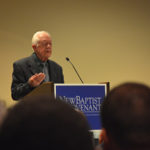WASHINGTON (ABP)—If ever there were an archetypal hangout for what author and urban-studies theorist Richard Florida calls the “creative class,” Busboys and Poets at 14th and “V” Streets NW in the nation’s capital is it.
|
Busboys and Poets offers affordable gourmet meals and a performance venue to edgy artists, sells books on political topics and provides a chic meeting space for activist groups.
|
The combination bookstore-bar-bistro-coffeehouse-theater sits near the heart of a neighborhood that has become multicultural hipster central in recent years. Opened in 2005 by an Iraqi-American restaurateur and community activist, Busboys’ mission includes offering affordable gourmet meals to the hordes of young do-gooders who make Washington their home, providing a performance venue to edgy artists, selling books on political topics and offering a chic meeting space for activist groups.
The restaurant and its neighborhood—like many gentrifying ones in large cities around the country—are thriving. One-bedroom condos in the building that houses Busboys still sell for upwards of $400,000, despite the nationwide housing bust that has sent the economy into a tailspin.
If ever there were a place that would seem less natural a hangout for your average Baptist, Busboys and Poets also is it.
Therein lies the rub for those seeking to minister to the rising class of young, educated professionals who are revitalizing once-blighted urban neighborhoods—but largely bypassing their struggling churches.
“One of the most significant challenges is that (neither) many churches nor communities really understand each other,” said Ron Johnson, an urban-missions professor at Mercer University’s McAfee School of Theology in Atlanta.
“The churches often have attitudes and assumptions about the communities that are incorrect because so many churches have not had conversation with the community in such a long time. And the community often prejudges the silence of the church as being simply an outdated religious institution and not connected with the real world.”

The once-blighted Chinatown neighborhood around Washington’s Calvary Baptist Church has experienced explosive growth.
|
University of Toronto professor Florida argued in his groundbreaking 2002 book, The Rise of the Creative Class, that the young, urban creative types who are revitalizing cities tend to be far more socially liberal and tolerant of diversity than the average evangelical. Florida asserted in the book and works that have followed it such diversity and tolerance helps build the “creative capital” that in turn fuels economic growth and creates thriving, successful cities in today’s economy.
Sign up for our weekly edition and get all our headlines in your inbox on Thursdays
“I think Florida’s right; that diversity is innately attractive to them,” said Peter Brown, a senior vice provost and philosophy professor at Mercer’s main campus in Macon, Ga. Brown, who has studied the urban-planning school known as “New Urbanism” under one of its founders at the University of Miami, said he thinks many traditional conservative evangelical churches in urban settings simply will be “left behind” by the trend of young professionals choosing big cities—or urban parts of smaller cities—over the suburbs.

Amy Butler was called as pastor of Calvary Baptist Church in Washington, D.C., in 2003.
|
“I think the folks that they have reached out to and have continued to reach out to are the people who feel alone and lost in the urban world, and … the churches at least around here continue to move out to the suburbs,” Brown, who has directed Mercer’s community-development work with blighted Macon neighborhoods near its campus, said.
“But I think this new demographic we’re talking about, they don’t feel the same. They enjoy the rootlessness; they like being mobile. … They like that excitement and that diversity, and I’m not sure that evangelicals respond to that or know how to respond to it or know what the gospel means in terms of those folks,” he said. “They’re seekers, but they’re not necessarily seeking … what the evangelical religion has typically offered, which is a combination of community and clarity or certainty.”
Amy Butler could sense the once-blighted Chinatown neighborhood around Washington’s Calvary Baptist Church was poised for explosive growth when she was called as the church’s pastor in 2003. She was right.
“I remember my first visit to the church and walking around and seeing that sort of edginess and sort of sensing that things were on an upturn. And I had this feeling that, you know, there was nowhere to go but up,” she said. “Our congregation is moving in. So, really, it’s just been about positioning the church in such a way that we become accessible to our neighbors.”

|
But that could mean difficult change for a church that had been in decline for years and most of whose middle-aged or elderly congregants drove in from the suburbs, Butler added.
“The tough thing … is that institutions are not particularly compliant, they don’t change particularly easily. And in order to be the church here and now, we have to adjust.”
Some of those adjustments have been ideological. The church developed a motto—complete with logo—heralding that it was “a different kind of Baptist church.”
But the church faced less obvious adjustments as well, Butler noted. One was actively marketing itself, adopting what she called “a consumer approach to church.”
“On one hand, many churches have taken this approach of, ‘We’ll have a coffee shop, or we’ll give people what they want to bring them in,’” Butler said. “I have been very resistant to that because that’s not how I understand my ecclesiology. But I agree that that has to be a reality, and here in D.C., it was easy to identify from the very beginning that the thing that we can give them —that is our marketing niche—is community. You know, people are lonely in this city. It’s a transient city.”
Much of the suburbanization of the United States in the 1950s was a result of young couples looking for idyllic communities in which to raise their children, noted Charles Tolbert, chair of the sociology department at Baylor University. But many of the grandchildren of those couples are moving back into cities to find communities they find idyllic in a different way, because they are diverse, sustainable, walkable and green.
“There’s a little irony there in the sense that that 1950s America was really full of strong community and, in fact, that strong community is being reproduced in these new urban settings by different kinds of people,” he said.
Tolbert said much of modern-day white American evangelicalism is obsessed with recreating the kinds of communities they imagine existed in that era. The irony is that the new communities don’t necessarily reflect their predecessors’ social mores.
“What they wish they had actually exists (in new urban communities), but I’m sure there’s a sense that, well, ‘That’s not our kind of people,’” he said.
But Butler said her church’s adjustment to its community, although difficult at times, has been worth it.
“I mean, we have a good product; I think the gospel of Jesus Christ is a good product,” she said. “And if we build a community that genuinely reflects Jesus’ mandate to love God and love others, I think people are going to notice that.”














We seek to connect God’s story and God’s people around the world. To learn more about God’s story, click here.
Send comments and feedback to Eric Black, our editor. For comments to be published, please specify “letter to the editor.” Maximum length for publication is 300 words.